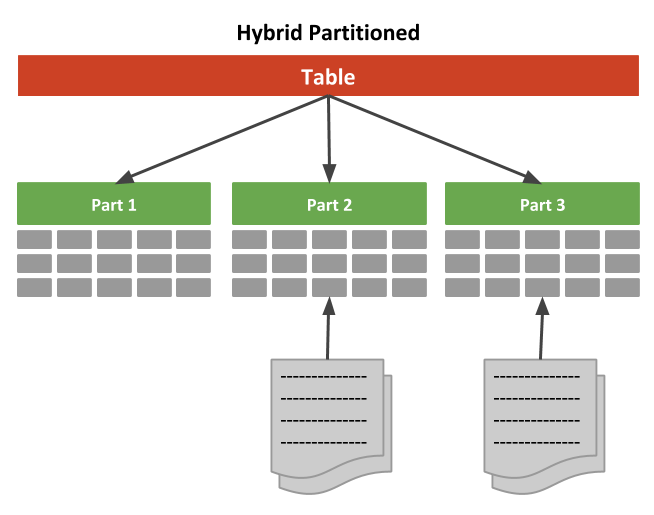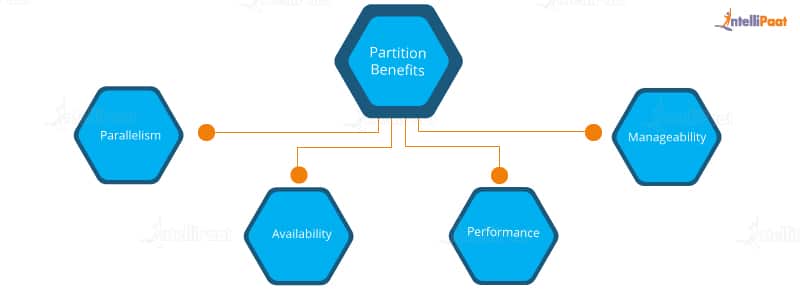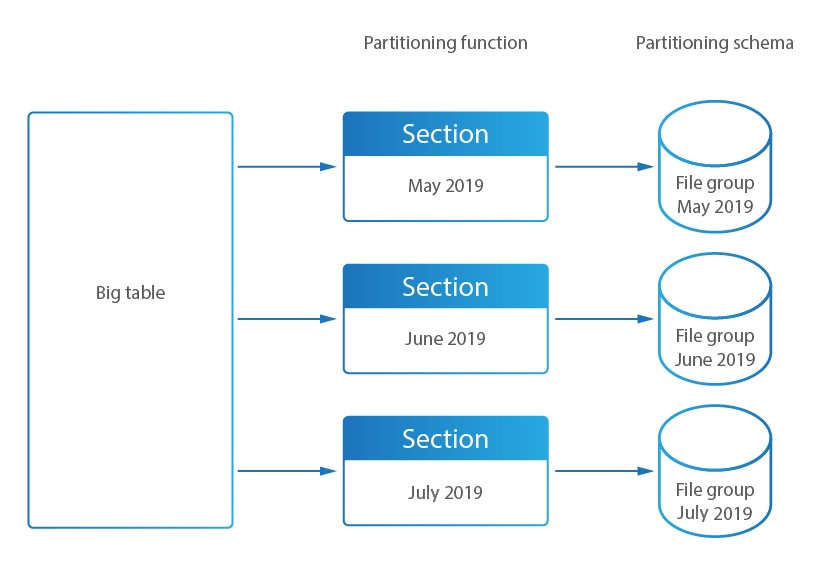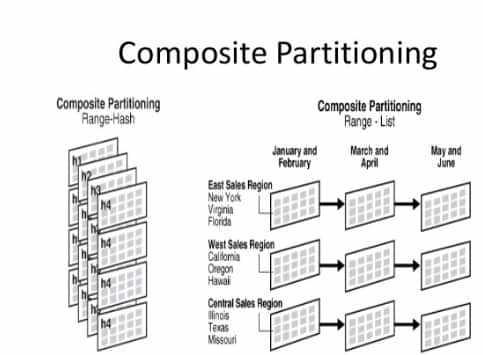Database Partitioning Types
Each piece of the database object is called a partition. Partitioning column is usually a datetime column but all data types that are valid for use as index columns can be used as a partitioning column except a timestamp column.

Oracle Base Hybrid Partitioned Tables In Oracle Database 19c
Databases and partitioning types ORACLE.

Database partitioning types. Type of partitioning and schema handling for partitions. If your table has grown fat ie there are too many columns which might be a major reason for slower writes then you have to think whether the columns are needed in one single table or can be normalized. SQL Horizontal Table Partition.
Each partition has its own name and may optionally have its own storage characteristics. Types of Partitioning. Composite Partitioning.
Equality range LIKE and IN-list predicates are considered for partition pruning with range or list partitioning and equality and IN-list predicates are considered for partition pruning with hash partitioning. Introducing PostgreSQL table partitioning to GitLabs database. This type of partitioning assigns rows to partitions based on column values falling within a given range.
Such a partitioning process is also known as row splitting. We can use partitioning techniques for dividing indexes and index-organized tables also. In SQL Server there are two types of table partitions.
Partitioning Types Range List Hash Interval. Interval Partitioning is a special type of range partitioning where the ranges in interval partitioning are always time based and are created automatically as you add new data new data to the table that should belong to a new interval range. This is a working document to discuss how we are going to introduce table partitioning to GitLab.
Partitioning Azure SQL Database. See Section 31 RANGE Partitioning. For example in part of an e-commerce system that tracks the orders that are placed by customers.
Horizontal partitioning involves putting different rows into different tables. Content reproduced on this site is the property of its respective owners and this content is not reviewed in advance by MariaDB. Each partition is known as a shard and holds a specific subset of the data such as all the orders for a specific set of customers.
These types are all available with Azure Cache for Redis and are described by the Data types page on the Redis website. Horizontal partitioning often called sharding. Basics of Partitioning Partitioning allows a table index or index-organized table to be subdivided into smaller pieces.
Partitioning Tables. Performance is best when the data evenly distributes across the range. For example value of year.
Range Partitioning - the data is distributed based on a range of values. The ntext text image xml varcharmax nvarcharmax or varbinarymax Microsoft NET Framework common language runtime CLR user-defined type and alias data type columns. It sets lower boundaries and upper boundaries to the partition.
We can improve performance when the number of pipeline partitions equals the number of database partitions. List Partitioning The data distribution is defined by a discrete list of values. The partitioning can be done by either building separate smaller databases each with its own tables indices and transaction logs or by splitting selected elements for example just one table.
Basically there are two methods or types of partitioning in datastage. One or multiple columns can be used as partition key. Partitioning feature is enable on Enterprise edition but if you use it in Enterprise edition then you need to have extra Partitioning license except Enterprise license.
In this article we will show you what is Horizontal Table Partitioning in SQL Server and how to create it with example. Use any number of pipeline partitions and any number of database partitions. Table partitioning helps in significantly improving database server performance as less number of rows have to be read processed and returned.
Range partitioning introduced in Oracle 8 List partitioning introduced in Oracle 9i Hash partitioning introduced in Oracle 8i Interval partitioning introduced in Oracle 11g Composite partitioning introduced in Oracle 8i System partitioning introduced in Oracle 11g. Lets create one range partition to understand it betterIt is generally used with DATE columns. It is widely used with DATE data types.
It is helpful to organize data for quick. Oracle supports a wide array of partitioning methods. Partition Pruning and Selection.
Table partitioning can be of two types namely vertical partitioning or horizontal partitioning. Used to assign each partition a range or a list of values. Dividing table into multiple tables is called Horizontal Table Partition.
In this article we will see types of partitions available in Oracle. You can use following different types of Partitioning in Oracle database. I will explain Partitioning Types in Oracle Database in the next article.
For information about an extension to this type RANGE COLUMNS see Section 331 RANGE COLUMNS partitioning. Below partition techniques which can be implemented in parallel stages explained with the examples. This type of partitioning is useful when dealing with data that has logical ranges into which it can be distributed.
Database Partitioning Partition Type. Use database partitioning for Oracle and IBM DB2 sources and IBM DB2 targets only. The two types of vertical partitioning are normalization and row splitting.
Equality range LIKE and IN-list predicates are considered for partition pruning with range or list partitioning and equality and IN-list predicates are considered for partition pruning with hash partitioning. Normalization is the standard database process of removing redundant columns from a table and putting them in secondary tables that are linked to the primary table by primary key and foreign key relationships. As the names suggest we can guess that partitioning is based on the key column whichever you defined.
You can access it with the following link. RANGE COLUMNS and LIST COLUMNS Partitioning Types. Range Partitioning works with range of column values.
In this strategy each partition is a separate data store but all partitions have the same schema.

What Is Partitioning Datasunrise Data Db Security

Partitioning Types Range List Hash Interval In Oracle Database It Tutorial

Database Partitioning Techniques Intellipaat Blog

Database Partitioning Techniques Intellipaat Blog
Posting Komentar untuk "Database Partitioning Types"